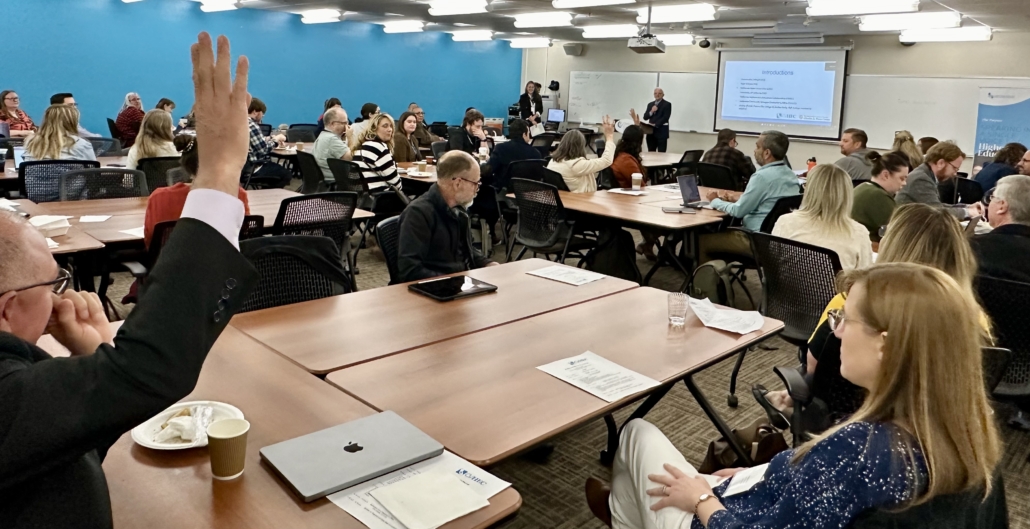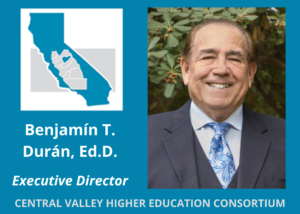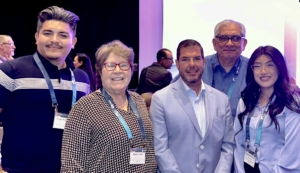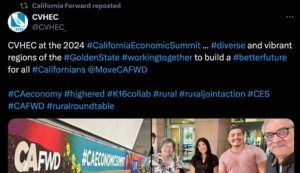
Central Valley’s math professionals go above and beyond
BY TOM URIBES
CVHEC Communications Coordinator
A “unique collaboration” was the vibe for more than 60 community college math educators and other education officials who met last month at the third meeting of the “Central Valley Way to AB1705 Success and Beyond” convening where they shared ideas and perspectives addressing implementation of Assembly Bill 1705 curriculum.
Presented by the Central Valley Higher Education Consortium Math Task Force with the Charles A. Dana Center (University of Texas at Austin), the Oct. 25 convening continued two years of discussion as Central Valley community colleges and their counterparts statewide prepare to meet the requirements of the state law related to equitable placement, support and completion practices for STEM programs.
Plans are already underway for the next math gathering in spring 2025 with a tentative March 28 date, said Dr. John Spevak, CVHEC regional coordinator who oversees the consortium’s Math Task Force and co-facilitator with Dr. Tammi Perez-Rice, Dana Center course program specialist.
“At that 2025 meeting, we will continue the vibrant conversation for even more intersegmental collaboration related to improving success for students in STEM math courses,” Spevak said.
In three virtual and three in person sessions beginning in early 2023, the task force addressed the various options available to the state’s community colleges for AB1705 implementation, a unique situation that the consortium has dubbed “The Central Valley Way” because of its innovative approach of bringing the region’s math community together for the first time.
“This confluence of thought and individuals of math faculty and math professionals is unique to California,” said Dr. Benjamín Durán, CVHEC executive director and president-emeritus of Merced College.
“This was truly a boots-on-the-ground campaign, and we commend the folks who rolled up their sleeves and crossed territorial lines to collaborate for a great impact on our students,” Durán said. “As many excellent educators are driven to do, some went above and beyond the call of duty, even working through the summer, to prepare for this culmination and beyond.”
After the various previous sessions leading up to the Oct. 25 gathering, which was held at the Clovis Community College Herndon campus, the task force narrowed its focus to three strands with cross-institution teams developing reports regarding:
- calculus 1 corequisite design and implementation,
- designing and implementing an innovative pre-calculus course,
- evaluating the efficacy of the courses in the path to calculus as reported out by strand leads.
Spevak said each community college has worked on its own plan to comply with the new legislation, for implementation in fall 2025, but the collaboration gave them the opportunity to see what sister Central Valley campuses were doing and feed off each other.
“Each college benefitted from the ideas presented by fellow college math educators,” Spevak said. “The comment most frequently heard was ‘I appreciated the opportunity to learn what other community colleges are doing and to share what my college is doing’.”
Joan M. Zoellner, the Dana Center’s Launch Years Initiative lead who also delivered a presentation, “National Best Practices in Math Student Success,” at the event summarized the outcome.
“Despite taking different approaches, all of the participants displayed dedication to student success, discussing a wide variety of topics including active learning, flipped classrooms, scheduling with other STEM departments and creatively leveraging existing campus resources such as MESA programs,” she said.
Spevak also noted that the spirit of collaboration extended to math educators from other segments who participated in the math gathering, including three Central Valley high schools and representatives from the California State University System and the University of California as well from UC campuses at Merced and Davis.
Dr. Erik Cooper of the California Community College Chancellors Office briefly discussed the AB1705 guidance.
Zoellner said of the vice chancellor’s Zoom appearance, “Attendees had the opportunity to pose several logistical questions that are still ambiguous.”
Sharing updates on work in progress throughout the Central Valley as well as statewide to enhance math education research, teacher training and student support were Dr. Lynn Cevallos of College Bridge, Dr. Ted Coe of the California Mathematics Education Collaborative, Dr. Fred Uy from the CSU Chancellors Office, Dr. Liz Rozell of the Kern Master’s Teacher Upskilling Project. Rolin Moe of UC Online sent comments presented to the group by Spevak.
Several high school officials and other higher education representatives also offered input throughout the day, highlighting the impression the Central Valley Way has made on the Dana Center representatives who work with several education organizations throughout the nation on math issues. In California, they have worked with CVHEC since 2018, when AB705 was initially being implemented and more recently into the current partnership focusing on the AB1705 implementation.
“We have been honored to work with the dedicated math faculty in the Central Valley over the course of these past years,” Zoellner said. “We have witnessed the thoughtful and intentional work by the faculty to design corequisite supports that will best support their local student populations, even when buy-in to the overall guidance was mixed.”
She echoed Duran’s assessment saying the cross-sector collaborative work happening in the Central Valley — including high schools, community colleges, CSUs and UCs — is unique in the state and in the country.
“The collaboration of many Central Valley community colleges, including small rural colleges, to share ideas, strategies and data will help identify and make the case for scaling effective ways of implementing AB1705 for similar schools in the state,” Zoellner said.
Perez-Rice said that this collaboration will be highlighted in a presentation by the Dana Center at the annual conference of the American Mathematical Association of Two-Year Colleges (AMATYC) in Atlanta Nov. 14-17 that will include two of the three CVHEC Math task Force strand leads who will share the CVHEC story addressing AB 1705 the past two years.
Set to participate in that national presentation are math professors Jeremy Brandl of Fresno City College and Shelley Getty of Taft College.
“So really the nation is seeing what is happening in the Central Valley of California and how CVHEC is leading the way showing what it means to convene like this; what it means to work across sectors to this caliber,” Perez-Rice said. “We hope the story behind the ‘Central Valley Way to Math Success’ collaboration will serve as a template for similar regional collaboration throughout the state and nation. It’s quite exciting.”
This national attention is possible “thanks to all the math professionals in our region for their dedication to math success for our Central Valley students,” Durán said in a recorded welcome for the group.
“You are all doing something unique — a collaboration of math educators working closely together to create the ‘Central Valley Way to Math Success.’ Now the work of your partnerships is being noticed nationally.”





